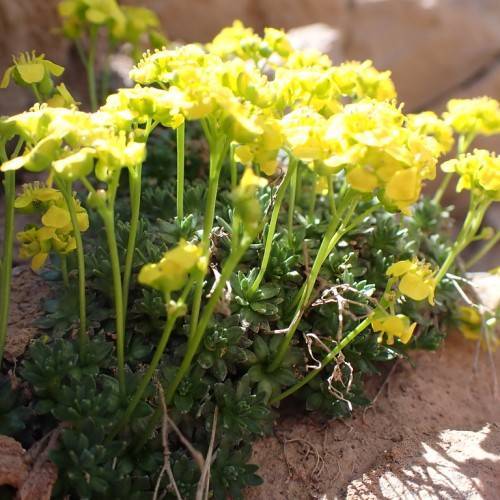
draba
Draba rigida var. bryoides
Cycle:
Herbaceous Perennial
Watering:
Average
Hardiness Zone:
4 - 8
Flowers:
Flowers
Sun:
Full sun
Leaf:
Yes
Growth Rate:
Low
Maintenance:
Low
Drought Tolerant:
Yes
Salt Tolerant:
Yes
Care Level:
Low
watering
Draba plants need to be watered deeply and infrequently. During the growing season, from March to July, it is best to water Draba plants every 7-10 days. Water the base of the plant and not the leaves to avoid crown rot. During the dry summer months, from July to September, water once a week if there is no rain. For the rest of the fall and winter months, from October to February, water monthly if rainfall does not reach 1 inch. Make sure to check the soil before watering and if it feels moist then do not water. As with most plants, over-watering can be just as bad as under-watering.
sunlight
The draba plant species requires direct sunlight in order to properly grow and thrive. This type of plant should receive full sun or partial shade, which generally means at least 6 hours of direct sunlight each day. However, when temperatures are especially high during the summer months, some protection from the hottest hours of the day may help keep the draba from overheating. In this case, shade during the peak afternoon sunlight hours will be beneficial. During particularly cold winter months, when temperatures can dip below 35 degrees Fahrenheit, Draba may benefit from some afternoon shade for protection.
pruning
Draba (Draba rigida var. bryoides) should be pruned twice a year, at the end of the winter season (March-April) and the end of the summer season (early September). Pruning should be done to maintain the overall shape and size of the plant, as well as to eliminate any dead or damaged branches. With minor pruning, the shrub can be trimmed to maintain its desired height and width. When undertaking major pruning, take care to remove no more than 1-third of the total branches annually. This helps maintain the natural structure of the Draba and prevents the plant from becoming overly stressed. Additionally, here are a few guidelines to follow when pruning your Draba: – Remove any dead, damaged or diseased branches. – Remove twiggy growth from the inside of the bush to improve air circulation, which will help the shrub look tidy and help reduce disease. – Thin the top of the shrub if it is too dense. – Prune out any crossing or rubbing branches. – Cut back and artistic group of branches growing in a linear direction. – Encourage more branching and more flowers by selectively removing the old flowering stalks at the point of origin, as this will help stimulate more vigorous flowering. – Cut back shoots in early spring to shape the shrub if necessary.
